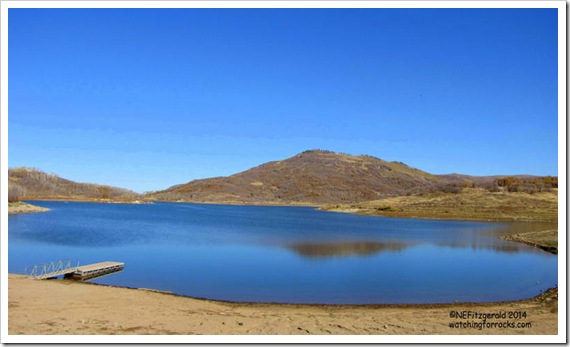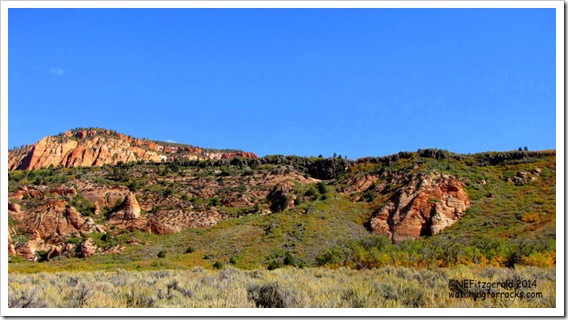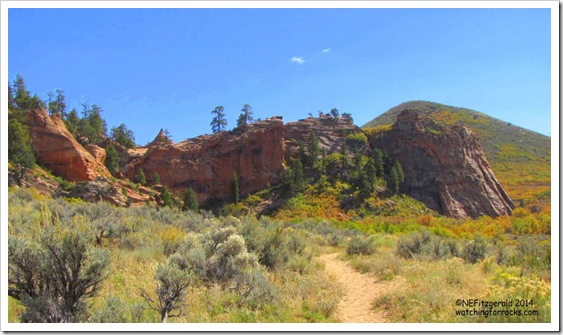This past weekend I found myself at loose ends. I am the proud owner of a new pair of birdwatching binoculars but had become weary of looking at flocks of house finches from my backyard patio perch. I wanted to go on a hike, but not one that was too strenuous or that involved packing much more than a bottle of water and an apple. With these simple criteria in mind, I decided to drive up to the Kolob Plateau area of Zion National Park and have a look around. It has been years since I’ve been up there and I was overdue for a visit.
 |
| Getting to Kolob Reservoir involves weaving in and out of a corner of Zion |
Plan A was a stop at Kolob reservoir, about 30 miles up onto the plateau from highway 9 and outside the Park boundaries. We are not on any major migratory flyway here in southwest Utah, and there had not been any recent storm, but you never know what sort of birdlife might blow in for a stopover. As it turned out, I did not see anything more than a gaggle of mallards dabbling in the water so it was on to Plan B. My binoculars and I turned around and drove back to the dry, dusty Hop Valley trailhead to see what we could see there.
 |
| Hop Valley trailhead |
Plan B involved hiking as fast (read: not very) and as far (read: also not very) as my booted size 9–ish feet cared to carry me on this gloriously clear–blue–sky mid–October day. I was in no hurry. In the immortal words of Chuck Berry, I had no particular place to go.
 |
| Spires and cliffs of Navajo Sandstone ring Hop Valley |
At around 6200 feet elevation, the trail weaves its way in and out of gambel oak forests. If there were any songbirds to be seen they would likely be within these trees and shrubs.
 |
| Gambel Oak are at their peak of color this mid-October day |
Somewhere in this autumn blaze of oak brush, a lone pink–sided dark–eyed junco fluttered and scuffled as I watched through my new binocs. The only other birds I saw were a pair of scrub jays calmly working their jay way across some branches. There are no pictures, though, except in my mind’s eye. They all refused to pose while I fumbled with my camera.
 |
| Here, little birdie! I know you are in there. |
Along the trail, the 10,900–foot high ridgeline of Pine Valley Mountain forms a backdrop for an outcrop of Navajo Sandstone slickrock.
 |
| Pine Valley Mountains dominates the distant skyline |
Sand, sand, sand everywhere! Soon there is sand in my boots and sand in my hair. It does not take long before sand is crunching in my teeth.
 |
| The sandy trail |
The Kolob Plateau has long been a hotbed of volcanic activity, as seen in the abundance of cinder cones and basalt flows.
 |
| A veneer of basalt covers Navajo Sandstone across the center of the image |
With an age of around 290,000 years, nearby Firepit Knoll is a likely source for the basalt in the image above, although there are numerous cinder cones in the vicinity. The geologic map of Zion calls the entire area “Quaternary volcanics.”
 |
| Firepit Knoll, a cinder cone |
Autumn wildflowers offer their own spectacle of color…
 |
| Globemallow |
 |
| Broom groundsel |
…as does the downy rabbit brush.
 |
| Rabbit brush |
This mullein “forest” wins the prize as one of the strangest sights I have ever seen in Zion. The plants rose up over several acres, their statuesque paddles of spent blossoms shifting in the breeze.
 |
| A mullein “forest” sways in the breeze |
 |
| Mullein paddles |
Someone lower to the ground was also out, enjoying the day.
 |
| I’m guessing snake track |
I never did see many birds, nor did I even make it all the way to Hop Valley proper. Still, the Kolob Plateau was a lovely place to while away a few easy hours, especially since I had no particular place to go and was in no hurry to get there.
 |
| Sandstone and cinder cones (this one is Spendlove Knoll) |






